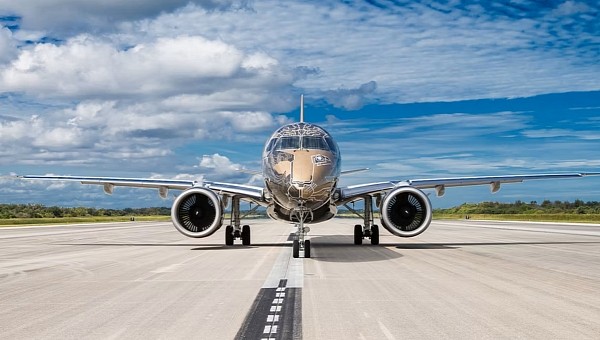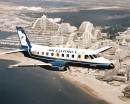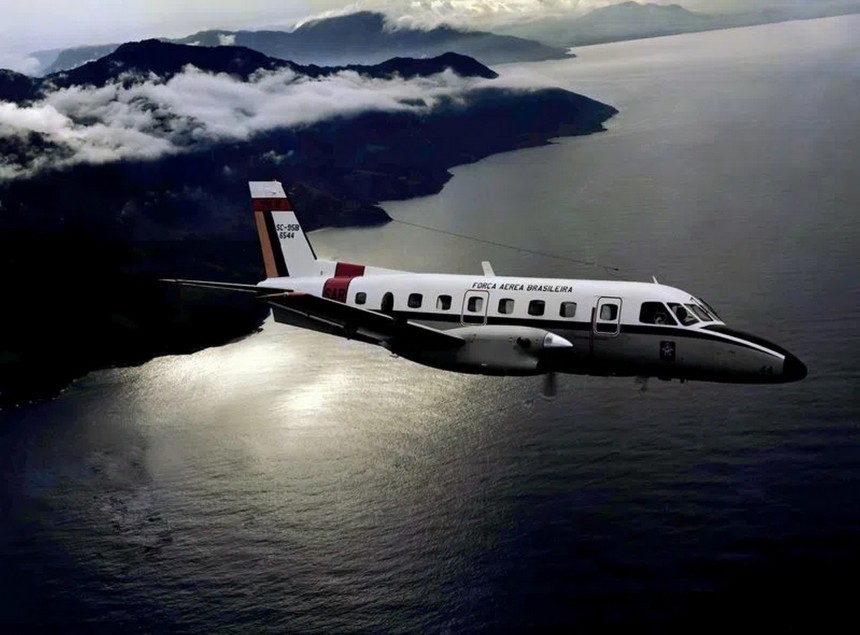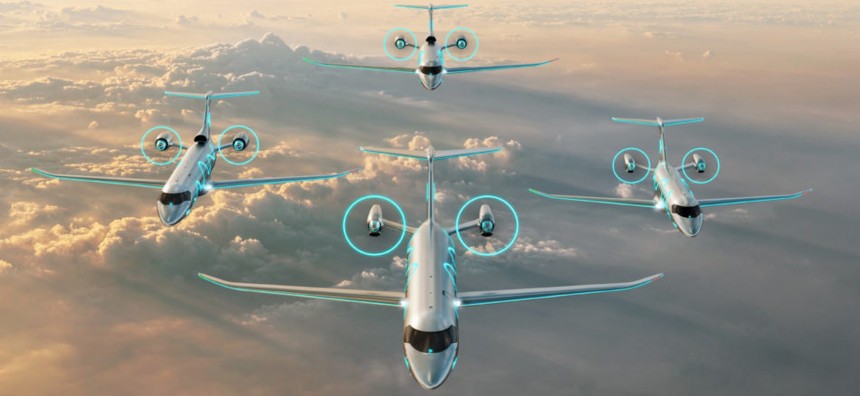There's a duopoly in modern commercial aviation. A two-company drag race between America's Boeing and Europe's Airbus for total dominance of the civil airliner space. At least, that would be the case if not for a handful of smaller manufacturers that challenge the yin and yang of the two largest fish in the pond. Among those, Embraer of Brazil might be the scrappiest of the bunch.
More so than Canada's Bombardier, it's hard to find industry analysts and experts who predicted Embraer would integrate so graciously into the cutthroat and sometimes unscrupulous North American civil aviation sector. In 2022, the company sold no less than 159 aircraft to both civil airliners and private charter services. This breaks down to 35 E175s, three E190s, one E190-E2, and 18 E195-E2s sold to commercial airlines and 117 sales of their private jets in the Phenom and Praetor series.
Through the new regime, the Empresa Brasileira de Aeronáutica (Embraer) group was founded, with its first president Ozires Silva being appointed by the Brazilian government itself. The first product of this novel Brazilian aerospace firm was the EMB 110 Bandeirante, a turboprop twin-engine regional airliner with a capacity for 18 people or possibly even more.
501 examples of this primordial Embraer jet were manufactured from 1968 to 1990 for both military and civilian organizations. The type laid the foundation for the company to explore developing different types of aircraft. In the 1970s and '80s, Embraer busied themselves designing the EMB 312 Tucano military trainer and the license-built copy of the Italian Macchi MB-326, dubbed the AT-26 Xavante.
In some form or another, both Embraer aircraft designed in this period formed a solid backbone for the company to slowly build. By 1985, the follow-up to the EMB 110 Bandeirante, the EMB 120 Brasilia, was making its first test flights. With a 30-passenger capacity and powerful Pratt & Whitney Canada turboprop engines, the type is even used in North America in some capacity as a cargo liner.
Such was the impetus behind the business jet variant of the Embraer Regional Jet civil airliner, the Legacy 600, which first flew in the year 2000. The smaller Phenom 100 and its stretched-out cousin, the Phenom 300. These smaller business jets are flanked by the more executive and VIP-focused Legacy 450/500 and Praetor 500/600. That's without mentioning the spectacular Lineage 1000, essentially just a luxurious VIP-oriented variant of an E190 twin-engine commercial airliner.
Combine this considerable horsepower in the private sector with the popular E-Jet and E-Jet E2 series of civil airliners, and you get a South American aerospace titan that even Airbus and Boeing can't ignore. By the late 2010s, it was to the point Boeing even mulled buying an 80 percent stake in Embraer. Proposing to effectively merge the talent pool of the world's oldest legacy airline manufacturer with the industry's most promising challenger to the established duopoly.
Even without an order backlog of $17.5 billion in E-Jets soon to be fulfilled, Embraer's exploits in the modern military sector are nearly as impressive as in the commercial space. The ultimate upgrade of the classic Tuccano would ultimately become the modern EMB 314 Super Tucano. A turboprop ground attack jet so good at its job that the U.S. military paid Embraer to manufacture the type under license in the United States with help from the Sierra Nevada Corp.
Couple that with the C-390 Millennium, the Brazilian alternative to the American C-130J Super Hercules, and Embraer's military exploits stand tall while the company also competes in the civilian space. That's without mentioning Embraer potentially manufacturing Swedish Grippen jet fighters in their own domestic facilities in the near future. Add it all together, and the results could soon be the Airbus-Boeing duopoly of the last 30 years coming to an end.
Ultimately, more competition in the aviation space can only be a net positive for industry innovation. One can't help but believe resting on one's laurels as if nothing could ever touch them is a key contributor to a stark decline in quality on the part of one particular airliner manufacturer. We're looking at you, Boeing. If we're to make a comparison to the automotive space, imagine if the only games in town were GM and Volkswagen. That'd be no fun for anybody.
Started from the bottom, now they're here to stay
It's a 12.7 percent increase in total sales over 2021, pretty spectacular growth in a time of such instability in the non-military aviation space. But to understand why Embraer laid its own claim to the airliner market, we need to know the story behind its origin. Founded in Sao Paulo, Brazil, in August 1969, Embraer would have perhaps never formed at all had it not been for a coup d'état five years earlier, which saw the beginning of a military junta government in the region.Through the new regime, the Empresa Brasileira de Aeronáutica (Embraer) group was founded, with its first president Ozires Silva being appointed by the Brazilian government itself. The first product of this novel Brazilian aerospace firm was the EMB 110 Bandeirante, a turboprop twin-engine regional airliner with a capacity for 18 people or possibly even more.
501 examples of this primordial Embraer jet were manufactured from 1968 to 1990 for both military and civilian organizations. The type laid the foundation for the company to explore developing different types of aircraft. In the 1970s and '80s, Embraer busied themselves designing the EMB 312 Tucano military trainer and the license-built copy of the Italian Macchi MB-326, dubbed the AT-26 Xavante.
Easing into life as a private company
After nearly over 20 years as a state-run entity, political reform in Brazil, starting in the early 90s, put Embraer down the path of privatization. Starting in 1992, the company was restructured in the private sector before being sold off to non-state affiliated investors in December 1994. Now emancipated from the majority of its government oversight, Embraer was free to pursue the lucrative regional and executive jet market with more ferocity.Such was the impetus behind the business jet variant of the Embraer Regional Jet civil airliner, the Legacy 600, which first flew in the year 2000. The smaller Phenom 100 and its stretched-out cousin, the Phenom 300. These smaller business jets are flanked by the more executive and VIP-focused Legacy 450/500 and Praetor 500/600. That's without mentioning the spectacular Lineage 1000, essentially just a luxurious VIP-oriented variant of an E190 twin-engine commercial airliner.
Combine this considerable horsepower in the private sector with the popular E-Jet and E-Jet E2 series of civil airliners, and you get a South American aerospace titan that even Airbus and Boeing can't ignore. By the late 2010s, it was to the point Boeing even mulled buying an 80 percent stake in Embraer. Proposing to effectively merge the talent pool of the world's oldest legacy airline manufacturer with the industry's most promising challenger to the established duopoly.
Doing just fine on their own
According to reports from Brazilian media, the global health crisis plus the international fiasco associated with the Boeing 737 MAX prevented the proposed 80/20 split between Boeing and Embraer from going through as planned. Even so, service contracts with dozens of global airlines to operate and maintain their fleets of Embraer jets are ensuring the company should do just fine on its own in the short term.Even without an order backlog of $17.5 billion in E-Jets soon to be fulfilled, Embraer's exploits in the modern military sector are nearly as impressive as in the commercial space. The ultimate upgrade of the classic Tuccano would ultimately become the modern EMB 314 Super Tucano. A turboprop ground attack jet so good at its job that the U.S. military paid Embraer to manufacture the type under license in the United States with help from the Sierra Nevada Corp.
Couple that with the C-390 Millennium, the Brazilian alternative to the American C-130J Super Hercules, and Embraer's military exploits stand tall while the company also competes in the civilian space. That's without mentioning Embraer potentially manufacturing Swedish Grippen jet fighters in their own domestic facilities in the near future. Add it all together, and the results could soon be the Airbus-Boeing duopoly of the last 30 years coming to an end.
Ultimately, more competition in the aviation space can only be a net positive for industry innovation. One can't help but believe resting on one's laurels as if nothing could ever touch them is a key contributor to a stark decline in quality on the part of one particular airliner manufacturer. We're looking at you, Boeing. If we're to make a comparison to the automotive space, imagine if the only games in town were GM and Volkswagen. That'd be no fun for anybody.
























